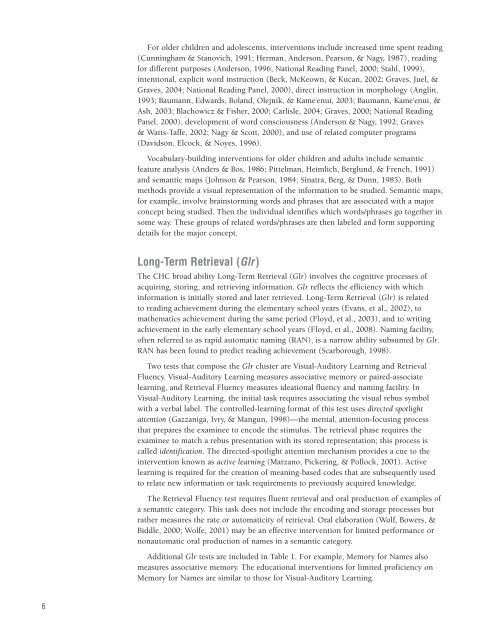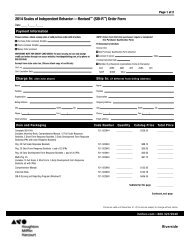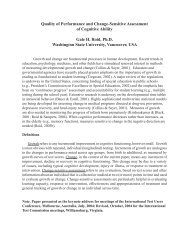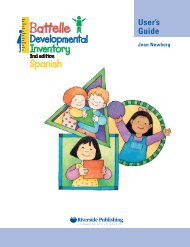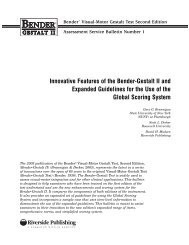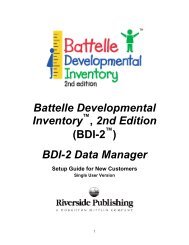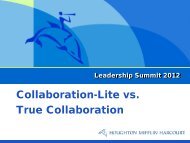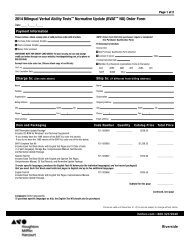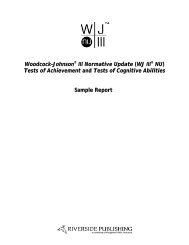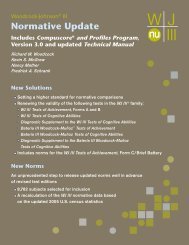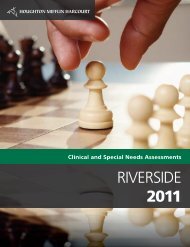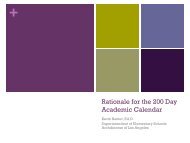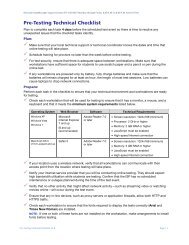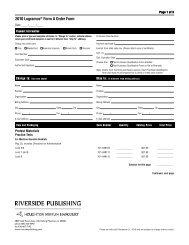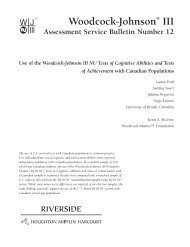Woodcock- Johnson III Tests of Cognitive Abilities - Riverside ...
Woodcock- Johnson III Tests of Cognitive Abilities - Riverside ...
Woodcock- Johnson III Tests of Cognitive Abilities - Riverside ...
Create successful ePaper yourself
Turn your PDF publications into a flip-book with our unique Google optimized e-Paper software.
For older children and adolescents, interventions include increased time spent reading(Cunningham & Stanovich, 1991; Herman, Anderson, Pearson, & Nagy, 1987), readingfor different purposes (Anderson, 1996; National Reading Panel, 2000; Stahl, 1999),intentional, explicit word instruction (Beck, McKeown, & Kucan, 2002; Graves, Juel, &Graves, 2004; National Reading Panel, 2000), direct instruction in morphology (Anglin,1993; Baumann, Edwards, Boland, Olejnik, & Kame’enui, 2003; Baumann, Kame’enui, &Ash, 2003; Blachowicz & Fisher, 2000; Carlisle, 2004; Graves, 2000; National ReadingPanel, 2000), development <strong>of</strong> word consciousness (Anderson & Nagy, 1992; Graves& Watts-Taffe, 2002; Nagy & Scott, 2000), and use <strong>of</strong> related computer programs(Davidson, Elcock, & Noyes, 1996).Vocabulary-building interventions for older children and adults include semanticfeature analysis (Anders & Bos, 1986; Pittelman, Heimlich, Berglund, & French, 1991)and semantic maps (<strong>Johnson</strong> & Pearson, 1984; Sinatra, Berg, & Dunn, 1985). Bothmethods provide a visual representation <strong>of</strong> the information to be studied. Semantic maps,for example, involve brainstorming words and phrases that are associated with a majorconcept being studied. Then the individual identifies which words/phrases go together insome way. These groups <strong>of</strong> related words/phrases are then labeled and form supportingdetails for the major concept.Long-Term Retrieval (Glr )The CHC broad ability Long-Term Retrieval (Glr) involves the cognitive processes <strong>of</strong>acquiring, storing, and retrieving information. Glr reflects the efficiency with whichinformation is initially stored and later retrieved. Long-Term Retrieval (Glr) is relatedto reading achievement during the elementary school years (Evans, et al., 2002), tomathematics achievement during the same period (Floyd, et al., 2003), and to writingachievement in the early elementary school years (Floyd, et al., 2008). Naming facility,<strong>of</strong>ten referred to as rapid automatic naming (RAN), is a narrow ability subsumed by Glr.RAN has been found to predict reading achievement (Scarborough, 1998).Two tests that compose the Glr cluster are Visual-Auditory Learning and RetrievalFluency. Visual-Auditory Learning measures associative memory or paired-associatelearning, and Retrieval Fluency measures ideational fluency and naming facility. InVisual-Auditory Learning, the initial task requires associating the visual rebus symbolwith a verbal label. The controlled-learning format <strong>of</strong> this test uses directed spotlightattention (Gazzaniga, Ivry, & Mangun, 1998)—the mental, attention-focusing processthat prepares the examinee to encode the stimulus. The retrieval phase requires theexaminee to match a rebus presentation with its stored representation; this process iscalled identification. The directed-spotlight attention mechanism provides a cue to theintervention known as active learning (Marzano, Pickering, & Pollock, 2001). Activelearning is required for the creation <strong>of</strong> meaning-based codes that are subsequently usedto relate new information or task requirements to previously acquired knowledge.The Retrieval Fluency test requires fluent retrieval and oral production <strong>of</strong> examples <strong>of</strong>a semantic category. This task does not include the encoding and storage processes butrather measures the rate or automaticity <strong>of</strong> retrieval. Oral elaboration (Wolf, Bowers, &Biddle, 2000; Wolfe, 2001) may be an effective intervention for limited performance ornonautomatic oral production <strong>of</strong> names in a semantic category.Additional Glr tests are included in Table 1. For example, Memory for Names alsomeasures associative memory. The educational interventions for limited pr<strong>of</strong>iciency onMemory for Names are similar to those for Visual-Auditory Learning.


